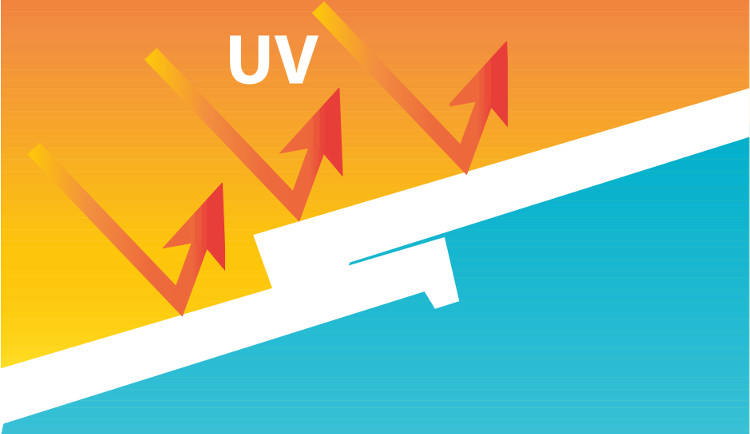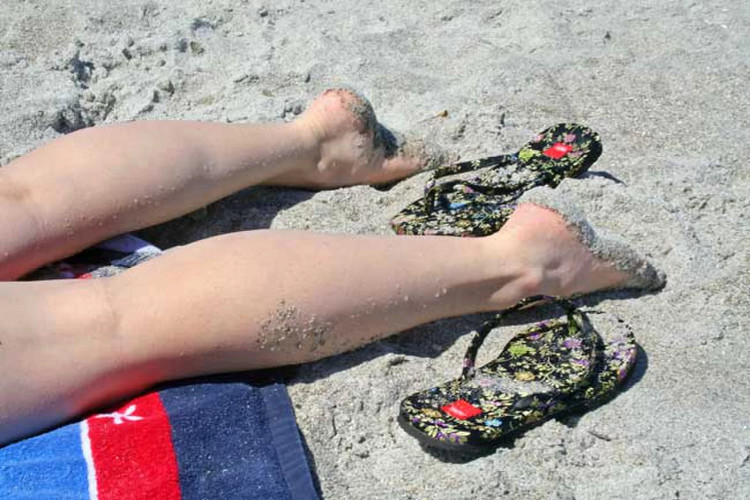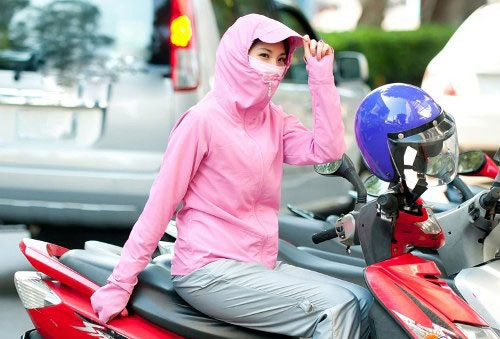Ultraviolet (UV) rays are a form of electromagnetic radiation that helps the skin synthesize vitamin D and stimulates the body’s main functions. Additionally, UV rays have the ability to kill bacteria, sterilize, and treat psoriasis.
Understanding Ultraviolet Rays (UV)
- Some Concepts & Classification of UV Rays
- Applications of UV Rays in the Ionization Process
- Effects of UVA, UVB, and UVC Rays
- Sunburn – A Clear Evidence of UV Effects on Humans
- How to Protect Against UV Rays
- Some Artificial UV Sources
- Fluorescence – An Application of UV Rays
- Applications of UV Rays in Astronomy
- Applications of UV Rays in Cancer Treatment
- The Key to the Origin of Life?
- What Factors Affect the UV Index?
- The UV Index and Levels of Harm
However, excessive exposure to ultraviolet rays can cause serious health problems and can even be life-threatening. Here are some facts about UV rays compiled by LiveScience:
Some Concepts & Classification of UV Rays
Electromagnetic radiation originates from the sun and travels through waves or particles at different wavelengths and frequencies. This range of wavelengths is called the electromagnetic spectrum (EM). The electromagnetic spectrum is divided into seven regions in order of decreasing wavelength, with increasing energy and frequency. Some common wavelengths include radio waves, microwaves, infrared rays, visible light, ultraviolet rays, X-rays, and gamma rays.

Ultraviolet rays (UV) are electromagnetic waves in the spectrum between visible light and X-rays.
Ultraviolet rays (UV) are electromagnetic waves in the spectrum between visible light and X-rays. UV rays have wavelengths ranging from (10 nm to 380 nm), corresponding to a frequency range of 8E14 Hz to 3E16 Hz. According to the U.S. Navy’s guidelines on UV radiation, UV rays are classified into three types based on their physiological effects:
- UVA (400 nm to 315 nm; 3.1 to 3.94 eV), also known as near UV.
- UVB (280 nm to 315 nm; 3.94 to 4.43 eV), also known as mid UV.
- UVC (180 nm to 280 nm; 4.43 to 12.4 eV), also known as far UV.
This guideline also states: “Radiations with wavelengths from 10 nm to 180 nm are sometimes referred to as vacuum UV or special UV rays.” These wavelengths are blocked by the atmosphere and only operate and propagate in a vacuum.
Applications of UV Rays in the Ionization Process
The energy of UV rays can break chemical bonds. UV photons, being higher in energy, can cause ionization – the process of removing electrons from atoms and creating a vacancy. This vacancy affects the biological components of the atom and causes them to form or break chemical bonds that they normally would not. This can be beneficial for biological processes or harmful to living tissues. These effects can be useful, for example, in sterilization, but they can also be harmful, especially to human skin and eyes – the areas most affected by UVB and UVC rays.
Effects of UVA, UVB, and UVC Rays
According to the National Toxicology Program (NTP), most UV rays that humans are exposed to come from the sun. However, only about 10% of sunlight is UV, and only 1/3 of this can penetrate the Earth’s atmosphere. Of the UV rays that can reach the Earth, 95% are UVA and 5% are UVB. No studies or measurements have shown the presence of UVC rays in the Earth’s atmosphere, as ozone, molecular oxygen, and water vapor in the upper atmosphere absorb all of these shorter wavelength UV rays. However, according to the NTP’s 13th Report on Carcinogens: “Broad-spectrum ultraviolet radiation – including UVA and UVB – are the strongest and most damaging agents to life on Earth.”
Sunburn – A Clear Evidence of UV Effects on Humans
Sunburn is a natural reaction to exposure to harmful UVB rays. Essentially, sunburn is the body’s natural defense response. The skin contains pigment cells called melanin, produced by skin cells known as melanocytes. Melanin absorbs ultraviolet rays and converts them into heat. When the body senses heat from sunlight, it sends melanin to surrounding cells and tries to protect them from potential damage. This causes the skin to darken.

The skin is the body’s natural shield against UV rays. (Image Source: Stock.Xchng).
“Melanin is a natural sunscreen,” Gary Chuang, assistant professor of dermatology at Tufts University School of Medicine, said in an interview in 2013. However, if the body continues to be exposed to UV rays, its natural defense system may become overwhelmed. This will lead to a reaction to the toxic substances, resulting in sunburn. UV rays can damage the DNA of the body’s cells. The body recognizes this and “directs” blood to that area to aid in recovery. Typically, if you are exposed to the sun for half a day, you will feel your skin redden and sting – more or less, depending on individual skin sensitivity.
Sometimes, DNA cells are mutated by UV rays, becoming problematic cells – those that do not die and even proliferate like cancer cells. Chuang stated, “UV rays can damage DNA cells as well as the DNA process, making cells immortal.”
The result is the development of skin cancer – the most common form of cancer in the United States and worldwide. Those who frequently get sunburned are at the highest risk for skin cancer. According to the Skin Cancer Foundation, the most dangerous form of skin cancer is malignant melanoma. This type has a risk of occurrence that is double for those who have been sunburned five times or more compared to the average person.
How to Protect Against UV Rays
Sun-Protective Clothing

You should choose light-colored sun-protective clothing.
You should choose thick fabrics with a high cotton content, which help protect against the harmful effects of ultraviolet rays while also easily absorbing sweat and limiting secretion on the skin’s surface.
Additionally, you should select light-colored sun-protective clothing and apply a layer of sunscreen to protect the skin, reducing the fabric’s heat absorption when outdoors in hot weather.
Wearing Sunglasses
Before purchasing sunglasses, check if they have a UV protection rating, and if so, consider the percentage according to the UV ANSI standard for selection. Additionally, sunglasses should be large enough to cover the entire eye area, helping to block UV rays and protect the eyes from wind and dust.
Using Sunscreen
The first method many people think of is using sunscreen to protect the skin from the harmful effects of UV rays. Many believe that if they cover up well when going outside, they don’t need sunscreen anymore, but this view is incorrect. It is best to limit outdoor exposure when the sun is blazing.
Staying Hydrated
In addition to external skin protection methods, you should drink enough water to help your skin stay healthy from the inside. Well-hydrated skin is one of the effective ways to combat sun exposure to ensure the body’s health and enhance the skin’s sun resistance, especially on hot sunny days.
Some Artificial UV Sources
Several artificial sources have been developed and used to generate UV rays. According to the Health Physics Society, “artificial sources include tanning devices, black lights, sterilization lamps, mercury vapor lamps, halogen lamps, high-intensity discharge lamps, fluorescent and incandescent lights, and some types of lasers.”
One of the most common methods for generating UV rays is passing an electric current through vaporized mercury or other gas vapors. This method is commonly used in tanning devices and for surface sterilization. They are also used in black lights to make fluorescent paints and dyes glow. LEDs, lasers, and arc lamps are also considered UV sources with various wavelengths for applications in industry, chemistry, medicine, and research purposes.
Fluorescence – An Application of UV Rays
Many substances – including minerals, plants, fungi, and bacteria, as well as organic and inorganic compounds – can absorb UV rays. This absorption causes electrons to reach higher energy levels. These electrons then return to lower energy levels in smaller steps, emitting a small portion of the energy they absorbed as visible light. Materials used as dyes or paints that are fluorescent in their composition will glow under sunlight because they absorb invisible UV rays and re-emit them at wavelengths visible to the human eye. For this reason, they are particularly useful in creating signs, safety warnings, and other applications to signal or highlight important messages.
Fluorescence can also be used to locate and identify certain minerals or organic materials. According to Thermo Fisher Scientific, Life Technologies, “Fluorescent light allows researchers to detect specific components of a complex set of biological molecules, such as living cells, with high sensitivity and selectivity.”
According to the University of Nebraska, in fluorescent tubes used for lighting, “ultraviolet radiation with a wavelength of 254nm is produced along with blue light emitted when an electric current passes through mercury vapor. This ultraviolet radiation is not visible to the naked eye but carries much more energy than the energy emitted from visible light. The energy from ultraviolet light is absorbed by the fluorescent coating inside the fluorescent lamp and re-emitted as visible light.” Similar tubes without a fluorescent coating that emit UV rays can be used for surface sterilization, as the ionizing effects of UV can kill most bacteria.

Besides the sun, there are many other sources of UV rays.
Black light tubes typically use mercury vapor to produce long-wavelength UVA light, causing certain substances to fluoresce. The glass is coated with dark purple filtering material to block as much visible light as possible, making the fluorescent light appear more pronounced. This filtering is not necessary for applications like sterilization.
Applications of UV Rays in Astronomy
Besides the sun, there are many other sources of UV rays. According to NASA, large stars will “shine” in the ultraviolet wavelength range. Because the Earth’s atmosphere blocks most of this type of radiation, especially at shorter wavelengths, observing stars is done using high-altitude balloons and telescopes equipped with specialized imaging sensors and filters to observe in the UV region of the electromagnetic spectrum.
According to Robert Patterson, an astronomy professor at Missouri State University, most observations are made using charge-coupled devices (CCDs) – detectors designed to detect short-wavelength photons. These observations can determine the surface temperatures of the hottest stars in the universe and reveal the presence of gas clouds between Earth and quasars.
Applications of UV Rays in Cancer Treatment
According to the Cancer Research UK, although exposure to UV rays can cause skin cancer, some skin diseases can be treated with ultraviolet light. In a treatment process called “psoralen ultraviolet light treatment” (PUVA), patients are given medication or apply a topical cream to make their skin sensitive to light. UV light is then directed onto their skin. The PUVA process is used to treat lymphoma, eczema, psoriasis, and vitiligo.
It may seem counterintuitive to use the cause of skin cancer to treat skin cancer, but in reality, the PUVA method can achieve this with the effects of UV on skin cell production. It slows down the growth of skin cancer cells, preventing the progression of this cancer.
The Key to the Origins of Life?
Recent studies suggest that ultraviolet light may play an important role in the origin of life on Earth, particularly in the origin of RNA. In a 2017 article in the Astrophysical Journal, the authors of this study noted that red dwarf stars may not emit enough UV rays to “activate” the biological processes necessary for the formation of ribonucleic acid – a prerequisite for the formation of all life forms on Earth. The studies also suggest that this finding could aid in the search for life elsewhere in the universe.
What Factors Affect UV Index?
Sun Elevation: The higher the sun is in the sky, the greater the UV radiation levels. UV radiation varies throughout the day and year, peaking around midday during the summer months. During the day, UV levels are usually highest near noon and in the early afternoon (from 10 AM to 4 PM), especially in late spring, summer, and early fall. Therefore, UV levels change throughout the day, lower in the morning, peaking at midday, and gradually decreasing as the sun sets.
Cloud Cover: UV radiation is highest when the sky is clear. However, even when it is cloudy, UV radiation remains high due to the scattering of UV rays by water molecules and fine particles in the atmosphere. The shade from clouds hardly reduces the effects of UV rays. Therefore, UV rays can still harm the skin and eyes, even in winter and on cloudy or rainy days.
Altitude: The higher the altitude above sea level, the less UV radiation is filtered by the atmosphere. For every 1,000 meters in elevation, UV levels increase by about 10-12%.
Latitude: The closer you are to the equator, the higher the UV radiation. The farther away from this position, the lower the risk.
Surface Reflection: UV radiation can “bounce” back when it hits reflective surfaces including water, sand, and snow. Snow can reflect up to 80% of UV radiation, dry sand on beaches reflects about 15%, and seawater about 25%. Therefore, swimmers, skiers, fishermen, or beachgoers can be affected by increased UV exposure from both above and below.
Ozone Layer: Ozone absorbs some of the UV radiation from sunlight reaching Earth. The greater the amount of ozone, the more protective filtering provided by the atmosphere. Depletion of the ozone layer can exacerbate health effects due to UV radiation exposure. As the ozone layer thins, humans will be exposed to higher levels of UV radiation, particularly UVB.
According to WHO, scientists predict that a 10% reduction in current ozone levels could lead to an additional 300,000 cases of non-melanoma skin cancer, 4,500 melanoma cases, and 1.6-1.75 million cases of cataracts worldwide each year.
UV Index and Levels of Harm
The UV index predicts the intensity of UV radiation at noon and is measured on a scale from 1 to 11+.
- UV Index 0-2.9: This index indicates very low levels of solar radiation for the day. You will be less affected by UV harm. Most people can be in the sun for about 1 hour during peak times (from 10 AM to 4 PM) without getting sunburned.
- UV Index 3-5.9: At this point, the UV radiation level is moderate. UV-related skin issues will be slightly more serious but still within acceptable limits. People with sensitive skin may get sunburned within 20 minutes. Wear a wide-brimmed hat and sunglasses to protect your eyes. Always use sunscreen with an SPF of at least 30 and wear long sleeves when going outside.
- UV Index 6-7.9: This index indicates relatively high levels of solar radiation. You should be more cautious when going outside. Wear a wide-brimmed hat and sunglasses to protect your eyes, nose, and ears. You should also apply sunscreen with an SPF of at least 30 and wear long clothing.
- UV Index 8-10.9: Summer days often have very high UV levels, from 8-10. If you are not careful, your chances of getting sunburned are very high. Those with sensitive skin may get burned in less than 10 minutes. Minimize sun exposure from 10 AM to 4 PM. Apply sunscreen with an SPF of at least 30. It is advisable to wear sunglasses and thick long clothing when outdoors.
- UV Index over 11: The UV level for the day is alarming. You can get burned in just 5 minutes without protection. It is best to stay indoors and keep windows closed rather than going outside at this time.
The Mystery of the Strange Stone Spiral Holes in Peru




















































